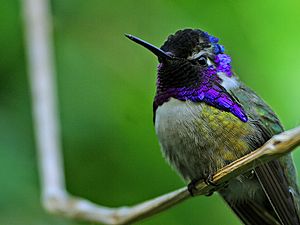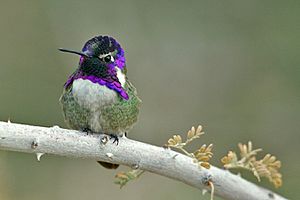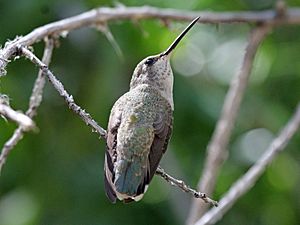Costa's hummingbird facts for kids
Quick facts for kids Costa's hummingbird |
|
|---|---|
 |
|
 |
|
| Conservation status | |
| Scientific classification | |
 |
|
| Range of C. costae Breeding range Year-round range Wintering range |
The Costa's hummingbird (Calypte costae) is a small bird that belongs to the hummingbird family called Trochilidae. These amazing birds are known for their bright colors and super-fast wing beats!
Contents
What Does a Costa's Hummingbird Look Like?
This hummingbird is quite tiny! An adult bird grows to be only about 7.5 to 9 centimeters (3 to 3.5 inches) long. Its wings can spread about 11 centimeters (4.3 inches) wide. Males usually weigh around 3 grams, and females are a little heavier at 3.2 grams.
Male Costa's hummingbirds are very striking. They have a green back and sides, with a small black tail and wings. Their most special feature is a bright purple cap on their head and a purple throat. The feathers on their throat flare out behind their head, almost like a fancy mustache! They also have white patches under their throat and near their tail.
Female Costa's hummingbirds are not as colorful as the males. They are mostly grayish-green on top and have a white belly underneath.
Where Do Costa's Hummingbirds Live?
You can often find Costa's hummingbirds in the dry, brushy deserts of the Southwestern United States. They also live in the Baja California Peninsula in Mexico. They sometimes visit gardens in these areas too.
How Do Costa's Hummingbirds Behave?
How Males Attract Mates
Male Costa's hummingbirds put on an amazing show to attract females! They fly in a spirited way, doing swoops and big arcing dives. They make sure to fly at just the right angle to the sun. This helps their bright violet feathers really shine and impress the female.
During these fast dives, the male will fly very close to the female, who is usually sitting on a branch. As he passes, he makes a high-pitched shriek! This sound actually comes from his tail feathers, not his voice. When he's not diving, the male will perch and make similar sounds, but these are vocal songs.
Building a Nest
The female hummingbird is in charge of building the nest. She creates a small, cup-shaped nest using plant fibers and soft down. Sometimes, she even uses spider silk to help hold it together! She covers the outside with lichen to make it blend in. The nest is usually built on a yucca stalk or a tree branch, high enough to be safe.
Baby Hummingbirds
A female Costa's hummingbird usually lays only two tiny, white eggs. She keeps the eggs warm for about 15 to 18 days until the young birds hatch. The baby hummingbirds stay in the nest for about 20 to 23 days before they are ready to fly out on their own.
What Do They Eat?
Like all other hummingbirds, Costa's hummingbirds love to drink nectar from flowers. Nectar is a sweet liquid that flowers produce. They also eat tiny insects that they find inside flower petals. These insects give them important protein.
Slowing Down for Sleep
When it gets cold at night, especially in the desert, Costa's hummingbirds can slow down their bodies. This is called torpor. It's like a deep sleep or a mini-hibernation. Their heart rate and breathing slow down a lot. This helps them save energy and survive the cold until the sun comes up again.
Conservation Status
Good news! The Costa's hummingbird population is stable, and there are no known major threats to them. Because of this, they are listed as a species of "least concern" by the IUCN (International Union for Conservation of Nature). They can be found in protected areas, which helps keep them safe.
Images for kids
See also
 In Spanish: Colibrí de Costa para niños
In Spanish: Colibrí de Costa para niños





